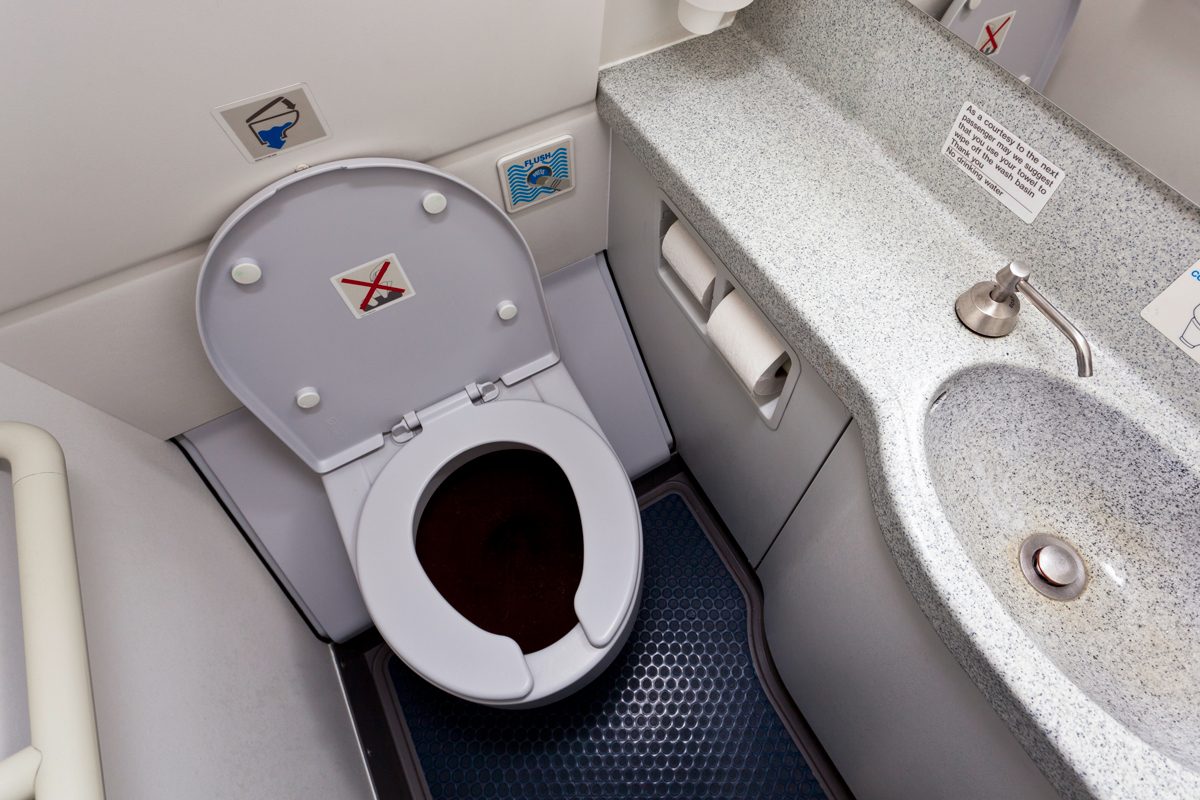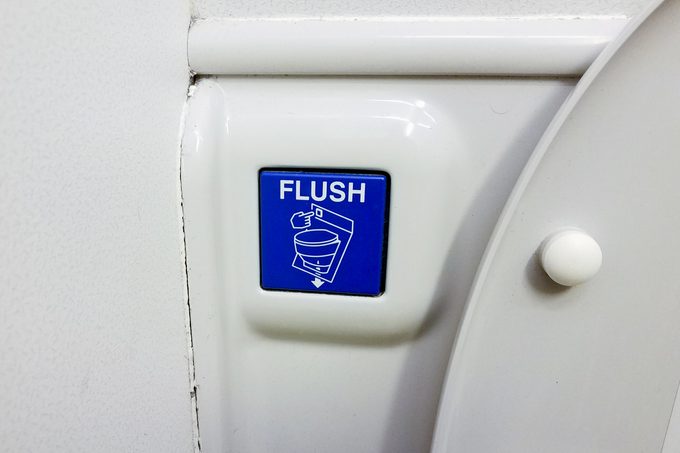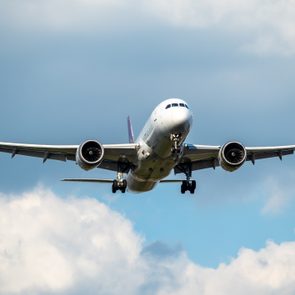During a flight, travelers could flush an airplane toilet up to 1,000 times—here's what happens to all that sewage

What Actually Happens When You Flush an Airplane Toilet?

Commercial planes weighing up to 800,000 pounds—that’s 400 tons—manage to routinely hurtle through the skies, delivering passengers safely to their destinations and providing essential services like food, entertainment and, of course, bathrooms. The largest aircraft can hold more than 800 people, and chances are, the majority of those people will have to use the airplane toilet at least once during a long flight. Now get a whiff of these airplane facts: On a long-haul 747 flight, travelers might flush the toilets around 1,000 times, creating roughly 230 gallons of sewage!
But what happens to all that sewage on a flight? It’s not like there’s plumbing to carry it away. And then there’s that violently loud swooshing sound, despite the lack of water, whisking the waste … somewhere. So what’s going on after you flush?
We got to the bottom of these questions and found out the answers behind the mystery of airplane bathrooms, straight from aviation experts. (Sorry, we couldn’t help ourselves.) Read on to find out exactly how airplane toilets work—we know you’re flushed with excitement!
Get Reader’s Digest’s Read Up newsletter for more travel, tech, cleaning, humor and fun facts all week long.
How does an airplane toilet work?

According to William A. Crossley, a professor of aeronautics and astronautics at Purdue University, airplane-toilet functionality has more to do with air pressure than water pressure—that’s why the flushing noise on airplanes is so powerful. “The toilets in the aircraft lavatory in nearly all modern passenger aircraft use pressure difference to flush,” he says, adding that there’s usually just a small amount of water to assist with flushing. “An aircraft toilet makes use of the fact that the atmospheric pressure outside is lower than it is in the cabin during flight.” This difference in pressure creates the suction to pull waste away when the flushing valve opens.
What happens when you flush?
“When a passenger flushes the toilet, the waste is sucked into a storage tank through a suction mechanism and pipes,” says Dan Bubb, PhD, a former airline pilot, a current associate professor at the University of Nevada, Las Vegas, and an expert on commercial aviation and airport history.
Crossley adds that because the waste is pulled with such high pressure into the holding tank, the toilet doesn’t need much or any water or fluid. “The pressure-assisted toilets are usually nonstick (like Teflon-coated) to make this work,” he says.
Where does all that waste go?
The waste goes through the pipe to the storage tank or tanks in the plane. “After the plane is parked at the gate, a ground-crew person driving a truck hooks up a hose to the storage tank to remove the waste,” says Bubb. “The driver then takes the waste to a location at the airport where it is safely, sanitarily and properly disposed of.”
Crossley says this is part of the standard turnaround tasks that are completed once a plane arrives at an airport and before it departs for its next flight. It’s also the reason that heading to the lavatory after boarding but before takeoff is the best time to use an airplane bathroom—because that’s when it will be the freshest.
FAQs

Can waste accidentally fall out of a plane?
With older flush systems, a very rare “blue ice” phenomenon could occur. Older flush systems used a blue waste-treatment liquid to assist the flush, and a small leak could result in the blue fluid seeping out during the flight. “If it made it to the outside of the aircraft, the liquid could freeze, given the low temperature at altitude,” Crossley explains. “There have been reported incidents—but very few—where a malfunction, generally a leak in the waste system, has allowed solid waste to escape.”
In 2023, there was a reported incident of stinky “brown rain” being dropped on two cars at a Minnesota drive-thru. In 2021, a man in England said he was splattered with human waste from the sky that was decidedly not frozen; also in 2021, a family in California said the same thing happened in their backyard. But in all these alleged incidents, the type of plane, airline and even exactly what happened weren’t confirmed.
Did commercial airplanes once dump their waste mid-flight?
Nope, this never happened—not with commercial airplane toilets, at least. Early passenger planes that contained toilets did aim to contain waste in a tank, and the vacuum flush technology still used for passenger airplane toilets today was developed back in 1975. So contrary to what you might have heard, it’s not just one of the things airlines don’t want to tell you: In reality, commercial aircraft do not have a history of dumping waste while flying. Bubb calls this “an urban legend.”
Did any airplanes ever drop waste in the air?
Commercial airplanes may not dump (or “jettison”) their waste midair, but what about military or other aircraft? Some early airplanes and military aircraft used during World War II weren’t equipped with proper toilets, just slosh buckets that could, well, slosh all over the place during air turbulence, or relief tubes or toilets that emptied to the air. “My understanding is that many older long-range military aircraft would jettison liquid waste [urine], which would generally evaporate very quickly at altitude,” says Crossley. But even older bombers would bring solid waste back to the airport or airfield, he adds.
Can you really get stuck on an airplane toilet if you flush while seated?
“You cannot get stuck on an airplane toilet when flushing it,” says Bubb. “The toilet suction will make a lot of noise, but that is all.”
Crossley concurs. “Using my basic engineering judgment, I don’t think you could form a tight enough ‘seal’ while seated on the toilet when you flushed to the point where you would actually be stuck,” he says. “I presume it might be uncomfortable to be subject to the relative vacuum from the flush, but the flush is really fast.” Even so, airplane bathroom etiquette says you should stand up before flushing.
Just how germ-filled is an airplane toilet?
Do you really want to know? Airplane bathrooms typically aren’t cleaned during the flight, which means they aren’t only receptacles for waste but also for just about every disgusting germ you can imagine. So one of the things you should never do in an airplane bathroom is touch the toilet seat, the flush button or pretty much anything else. Touch as few surfaces as possible, right down to using a paper towel to open and close the door and push the flush button. And please, please, don’t even think about going into the airplane bathroom wearing only your socks. Just no.
Where does water come from in an airplane bathroom?
You’ve probably noticed the signs indicating that the sink water in an airplane bathroom is not potable (drinkable). Technically, Crossley says it should be, but he doesn’t recommend drinking it. “Most aircraft have a water system with tanks that are filled at the airports with potable water,” he explains. “The water coming on board is potable, and the tanks and water system on board are kept clean enough to avoid bacteria from forming.”
But, he adds, there have been studies indicating that keeping the water tanks and system clean on the aircraft might be a challenge. “So even though potable water was loaded on board the aircraft,” he says, “the water tanks and system might not be clean enough to guarantee that the water is potable.”
This also goes for the ice in your drinks while flying—best not to get anything on the rocks when you’re in the air. Your best bet for staying hydrated, notes Bubb, is to stick with bottled water. You can bring a large refillable water bottle to fill at the airport after you go through security. The airplane sink should really not be used for anything except washing your hands. Airplane bathrooms are a necessity, but one you want to have as little contact with as possible.
About the experts
|
Why trust us
Reader’s Digest has published hundreds of travel stories that help readers explore the world safely, easily and affordably. We regularly cover topics such as the best places to visit (and the best times to visit them), tips and tricks to zoom through airport security, flight-attendant secrets, hotel-room hacks and more. We’re committed to producing high-quality content by writers with expertise and experience in their field in consultation with relevant, qualified experts. We rely on reputable primary sources, including government and professional organizations and academic institutions as well as our writers’ personal experiences where appropriate. For this story on how an airplane toilet works, Elizabeth Heath tapped her experience as a longtime travel journalist to ensure that all information is accurate and offers the best possible advice to readers. We verify all facts and data, back them with credible sourcing and revisit them over time to ensure they remain accurate and up to date. Read more about our team, our contributors and our editorial policies.
Sources:
- William A. Crossley, PhD, professor at the School of Aeronautics and Astronautics, Purdue University; email interview, November 2024
- Dan Bubb, PhD, former airline pilot, current professor at the University of Nevada, Las Vegas, and author of Landing in Las Vegas: Commercial Aviation and the Making of a Tourist City; email interview, November 2024
- Australian Broadcasting Commission: “So a frozen ball of poop fell from the sky—should we really be worried?”
- Henry B. Tippie National Aviation Education Center (NAEC): “Toilets During WWII”
- BBC: “Plane drops sewage on Windsor man in his garden”
- CBS News: “Did an airplane drop poop over a Burnsville neighborhood?”
- Kobi5: “California family believes human waste fell on home from airplane”























